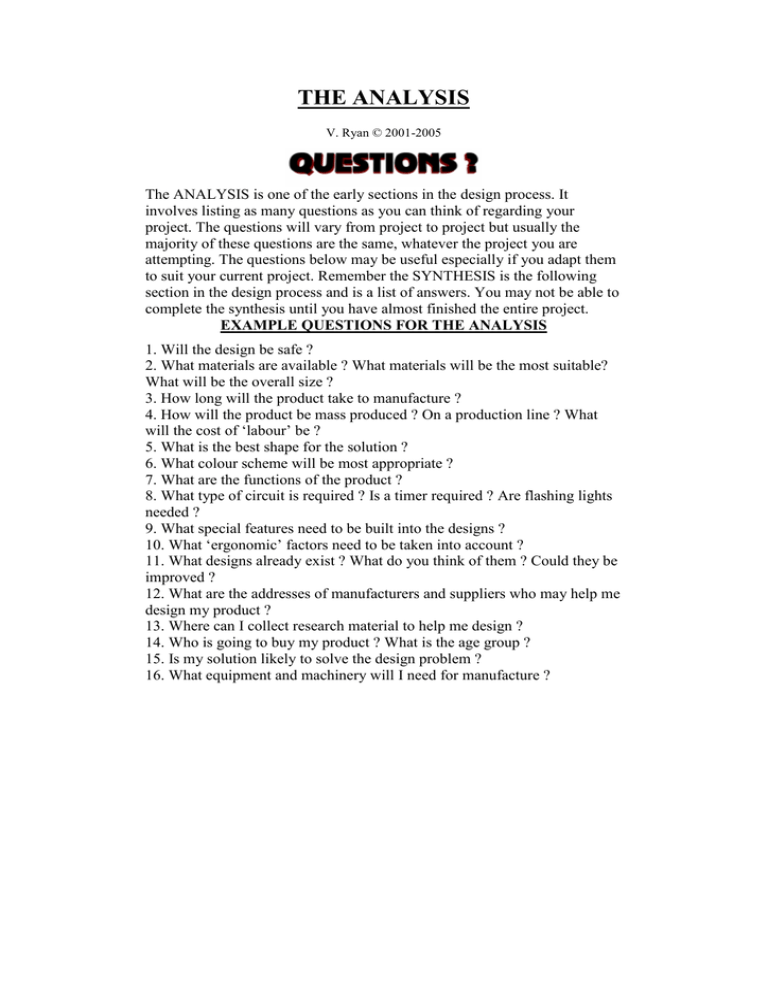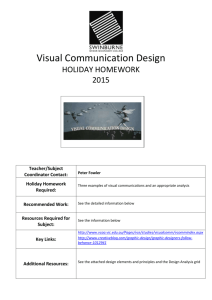THE ANALYSIS
advertisement

THE ANALYSIS V. Ryan © 2001-2005 The ANALYSIS is one of the early sections in the design process. It involves listing as many questions as you can think of regarding your project. The questions will vary from project to project but usually the majority of these questions are the same, whatever the project you are attempting. The questions below may be useful especially if you adapt them to suit your current project. Remember the SYNTHESIS is the following section in the design process and is a list of answers. You may not be able to complete the synthesis until you have almost finished the entire project. EXAMPLE QUESTIONS FOR THE ANALYSIS 1. Will the design be safe ? 2. What materials are available ? What materials will be the most suitable? What will be the overall size ? 3. How long will the product take to manufacture ? 4. How will the product be mass produced ? On a production line ? What will the cost of ‘labour’ be ? 5. What is the best shape for the solution ? 6. What colour scheme will be most appropriate ? 7. What are the functions of the product ? 8. What type of circuit is required ? Is a timer required ? Are flashing lights needed ? 9. What special features need to be built into the designs ? 10. What ‘ergonomic’ factors need to be taken into account ? 11. What designs already exist ? What do you think of them ? Could they be improved ? 12. What are the addresses of manufacturers and suppliers who may help me design my product ? 13. Where can I collect research material to help me design ? 14. Who is going to buy my product ? What is the age group ? 15. Is my solution likely to solve the design problem ? 16. What equipment and machinery will I need for manufacture ? THE DEVELOPMENT SECTION V. Ryan © 2001-2006 The Development follows the IDEAS section. A good way to start a development is to draw your best idea in the middle of the page and write around it areas of your design that need improving. For instance, you may need to improve the colour scheme OR the circuit may need improving further. Alongside each area write a few notes of explanation. Then, produce one A4 sheet for each area e.g. See circuit ‘development'. CAN YOUR DESIGN BE IMPROVED ? MATERIALS - You must choose materials and state how they can be combined to produce your final design. COLOUR - Produce a colour scheme for the final design. SAFETY - You may be able to show how you have improved the safety aspect of your design. COST - Work out the cost of your product. You may wish to use a spreadsheet for this purpose. CIRCUIT - Select a circuit from the ideas section and improve it further - stage by stage. MECHANISM - You may need to develop mechanisms or gear systems for your project. SHAPE - Can you improve the shape of your design ? If so show how. INDUSTRIAL MANUFACTURE You must draw each stage of your ‘products’ manufacture (in industry). Above is an example of an educational toy. Notes are arranged around the drawing, referring to various aspects of the design that can be improved or need developing You must decide the areas to develop. Think carefully how your design can be improved ! FURTHER INFORMATION - THE DEVELOPMENT SECTION The development section of a project is extremely important especially if you are aiming for a high grade. In this section you must select your best idea and explain how it can be improved and investigate new aspects. On the first sheet the best idea is drawn and aspects that can be improved are identified. All designs can be improved and outlined below are aspects that you may wish to consider when improving your idea. Costing your project and Health and Safety relating to it must also be investigated. 1. Select your best idea carefully. You may decide that selecting aspects from many designs and putting them together as one idea is preferable to selecting one complete idea from a range. 2. The development must show that you understand that your idea can be improved and developed. Think carefully about how improvements can be made and ask others for their views. 3. Draw your selected idea in the centre of the page and identify improvements. Use headings for each aspect and then write a short paragraph regarding how you intend to make improvements. 4. Identify up to 6 or 7 improvements. Include headings such as Health and Safety and Cost. Other aspects may be; shape / colour, Industrial manufacture, materials, circuits and other improvements that only apply to your project such as CAD/CAM and mechanisms. 5. The idea can be drawn in a simple but accurate way. Sometimes it is best to keep to a plain drawing without colour and shade. This means that the attention of a person looking at the sheet will be drawn to the written explanation. 6. Do not crowd the page with notes. Additional notes and drawings will be included on the following development sheets. 7. In the development section each area to be improved has its own development sheet. This means the development section is 6 to 7 sheets in length. 8. Look at old projects to see how pupils have successfully organised their development sections. Learn from their mistakes and build a comprehensive section. EXAMPLE DEVELOPMENT SHEETS Educational Toy for a Young Child Electronic Control System for a Green House CLICK HERE FOR MORE DEVELOPMENT SHEETS SUMMARY: A. Ask the views of others regarding which of your ideas is potentially best. B. Take time to decide which aspects of your design need improving and which need further investigation. C. Draw the idea in the centre of the page, keep the drawing simple, clear and accurate. D. Keep notes simple and precise and arrange them around the drawing. E. Complete your homework on time. Do not fall behind as you may find it impossible to catch up. HOW TO COST A PROJECT V. Ryan © 2001-2005 Any company manufacturing a product or a supplier supplying goods have to calculate their costs very carefully. The cost of employing people to promote, manufacture, market and sell products should not be overlooked when you are designing a solution and you must carefully explain the costing of designs, especially when you select your best idea and develop it. There are two types of costs - ‘fixed costs’ and ‘variable costs’ FIXED COSTS VARIABLE COSTS These are costs that do not increase or These change as output increases and decrease as output fluctuates. For example, include such things as materials required to salaries of employees, rent for premises manufacture the product. If production and advertising costs. increases then more materials are needed and consequently costs increase. TOTAL COSTS = FIXED COSTS + VARIABLE COSTS EXAMPLE - Imagine you have designed a clock and intend to produce it on a large scale (called mass production). The costs would have to be calculated in detail before you could secure a loan from a bank which would allow you to set up the business/company. The table below suggests a method of setting out the costs. Complete the table above by filling in the total costs and unit costs. UNIT COST = TOTAL COST / NUMBER PRODUCED Costing a project with a view to producing it on a mass production line is an aspect of design work and you must present this as part of the development section of the design process. Having decided which of your ideas is the best, ‘cost’ its’ manufacture. EXAMPLE COSTING SHEET



